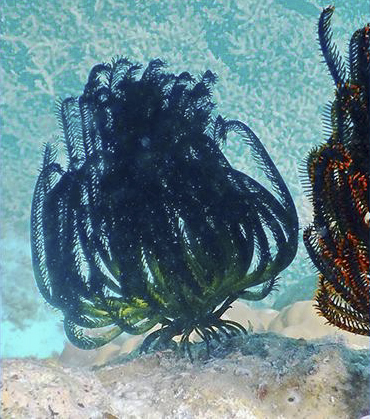Published in the Ocean Watch column, Honolulu Star-Advertiser © Susan Scott
November 16, 2015
PALAU >> In some of my favorite snorkeling spots here in Palau, I don’t have to stroke my arms or even move my fins to see vast stretches of coral reef. With Palau’s tidal range of 6 to 7 feet, and two high and two low tides daily, the current along the edges of deep channels is sometimes strong enough that we snorkelers have little choice of where to go. There’s nothing to do then but relax and let the ocean have its way.
 A crinoid walks along the sea-bed in the waters of Palau.
A crinoid walks along the sea-bed in the waters of Palau.
©2015 Susan Scott
Drifting effortlessly above colorful coral reefs is fantastic, but it’s hard to get a good look at a particular organism. By the time I turn around and swim up-current, I’ve often lost sight of what I wanted to look at. Also, there are no handholds to help a person steady a camera. Touching coral is a strict no-no, and it’s almost all coral.
But drift snorkeling has a big plus. Moving water offers free delivery to suspension feeders such as sea fans, soft corals and other wonders. Among those wonders are feather stars, also known as crinoids.
Crinoids (not found in Hawaii) are starfish and sea urchin relatives but have a shape and lifestyle all their own.
Crinoids get to touch the coral. The black, green and orange creatures stand in the open on coral heads, positioning their multiple feathery appendages in the current.
Tiny tube feet tipped with sticky mucus stick out from both sides of each arm. When the moving water brings tiny plants and animals to the crinoid, they get stuck in its glue.
This starts the crinoid’s ingestion assembly line. The outer tube feet flick the food to inner tube feet that cover it in slippery mucus and then deposit the catch in a groove at the center of each arm. There tiny hairs act like conveyor belts, transporting the meal to the creature’s mouth at the center.
Although they can walk and even swim, most crinoids find a spot they like and park there. Because crinoids have rootlike feet, a walking feather star looks a mutant flower searching for a sunnier spot.
Compared with 500 million years ago when they covered the ocean floors, crinoids are rare today. But their fossils are not. Among other places, they’re abundant in the Midwest. Missouri’s state fossil is the crinoid.
Drift snorkeling here isn’t scary because at the end of the channels, the water spreads out and the current stops. In addition, the boat goes with you. Palau’s boat drivers follow snorkelers and divers, so you can get out of the water when you like.
I’m soon starting my second Palau tour as a naturalist for the Oceanic Society, and even though I don’t know what I’ll see, I know one thing for sure. I will go with the flow.